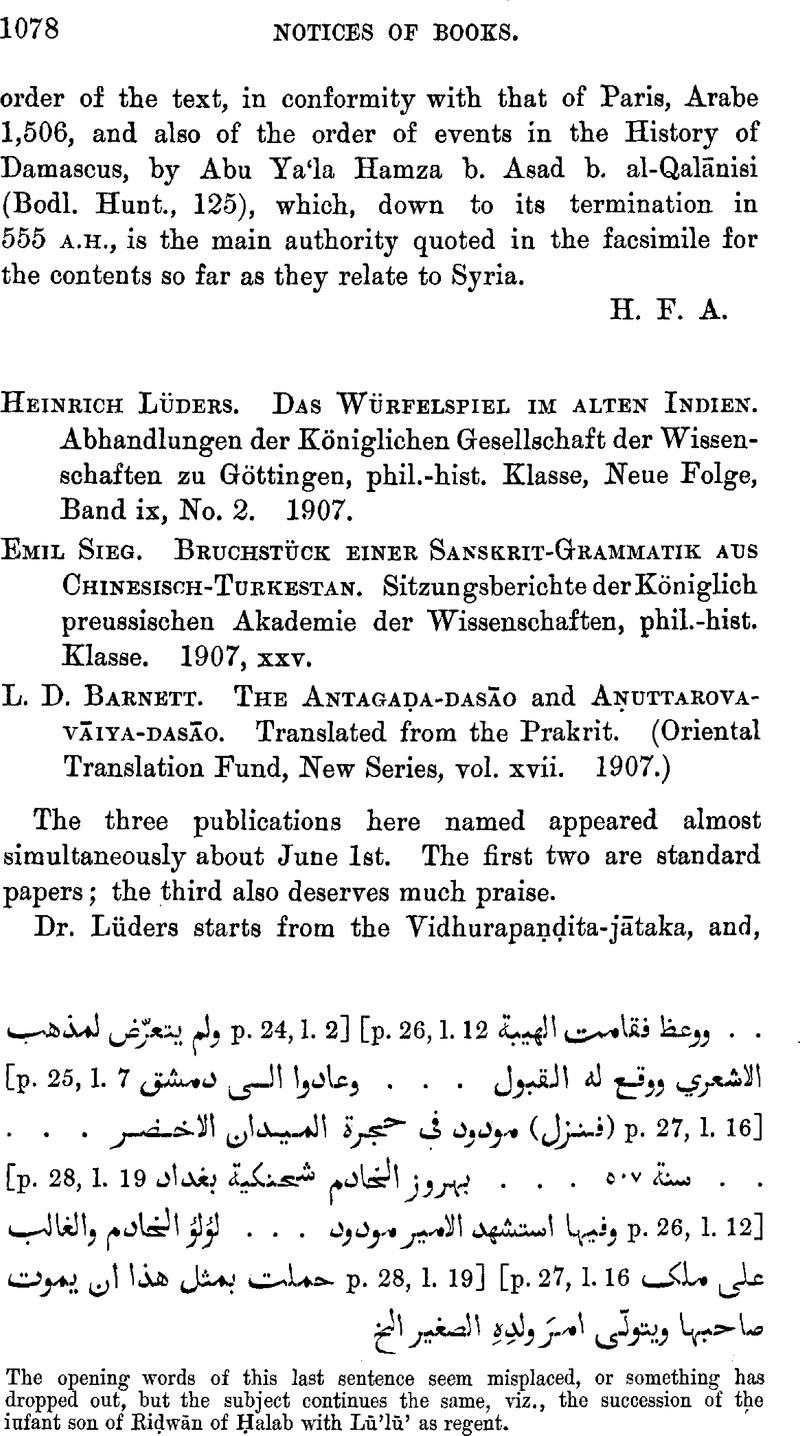No CrossRef data available.
Article contents
Heinrich Lüders. Das Würfelspiel im alten Indien. Abhandlungen der Königlichen Gesellschaft der Wissenschaften zu Göttingen, phil.-hist. Klasse, Neue Folge, Band ix, No. 2. 1907. - Emil Sieg. Bruchstück einer Sanskrit-Grammatik aus Chinesisch-Turkestan. Sitzungsberichte der Königlich preussischen Akademie der Wissenschaften, phil.-hist. Klasse. 1907, xxv. - L. D. Barnett. The Antagaḍa-dasāo and Aṇuttarova-vāiya-dasāo. Translated from the Prakrit. (Oriental Translation Fund, New Series, vol. xvii. 1907.)
Published online by Cambridge University Press: 15 March 2011
Abstract

- Type
- Notices of Books
- Information
- Copyright
- Copyright © The Royal Asiatic Society 1907
References
page 1080 note 1 Wiener Zeitschrift für die Kunde des Morgenl., iii, pp. 347–350Google Scholar. In addition to the arguments here given many more might be produced. Among these I only mention some that can be derived from printed books:—
(a) A Sanskrit rendering of the ahāsuhaṃ phrase, expressly styled as an answer, is found in Abhayadeva's commentary on Bhagavatī, xviii, 10, ed. Benares, , fol. 1428b 2.Google Scholar
(b) A metrical Sanskrit variation of the ahāsuhaṃ phrase, also styled as an answer, occurs in Hemacandra's Pariśiṣḍaparvan (Bibl. Ind.), iii, 280.Google Scholar
(c) The word preceding an ahāsuhaṃ phrase is proved to be final by plenty of abbreviations. So, in Dr. Barnett's text, the passage jāva pavvayāmi (p. 12827) shows that in Bhagavatī, , ix, 33Google Scholar (ed. Benares, fol. 803), Jamāli's words run on only till pavvayāmi, not till paḍibandhaṃ.
page 1080 note 2 The meaning of paḍibandha, ‘binding of the soul, addiction to, nidāna,’ recalls one of the meanings of anubandha; compare in Mahābhārata, iii, 13178, na kriyatām anubandhaḥ, ‘do not stick to your wish.’ In the smaller St. Petersburg dictionary the heads Ib and le of the article anubandha should be combined under the meanings “addiction to, particular wish, intention.”
page 1081 note 1 “Über ein Fragment der Bhagavatī,” ii (1867), p. 257.Google Scholar
page 1081 note 2 L.c, p. 302.
page 1081 note 3 L.c, pp. 261, 296; 256, 303. The book under notice, pp. 58, 80, 81. It may be mentioned here that some addresses of the kind have been entirely misunderstood, even by Malayagiri. In his commentary on the second Upānga (Rājapraśni, , Calc. ed. saṃvat, 1936, p. 30Google Scholar) he takes devā (t)i in the sense of dev'āi, and therefore paraphrases the words ‘deva’ i samaṇe bhagavaṃ Mahāvīre te deve evaṃ vayāsī by dev'ādi-yogād dev'ādi-śramaṇo bhagavān Mahāvīras tān devān evam avādīt. In the same book similar mistakes are found on pages 74 and 76 (both times the text has ‘Sūriyābhā’ i), and perhaps also elsewhere. But ‘bhante’ tti is rightly interpreted on p. 96 f. Only an optional blunder is committed by Abhayadeva when he says that ‘Goyama’ (t)i may in Sanskrit either be Gautamêti or Gautamûyi (i.e. ayi Gautama); see for instance Bhagavatī, ed. Benares, fol. 794 f.
page 1081 note 4 The subscriptions offer the half-Sanskritic plural ajjhayaṇāṇi (not ajjhayaṇāiṃ) and the numeral bīya (not, as the text puts, biiya or bitiya).
page 1081 note 5 The latter form, offered by the manuscripts, is also required by the veḍhaya-(veṣṭaka-) metre of the canon. Professor Jacobi, who has discovered the metre, calis it Hypermetron; see Weber's, “Indische Studien,” xvii, p. 389 ff.Google Scholar Its original designation, veḍhaya, is preserved in the canon. Later compositions of the type are found in the verses 9, 11, and 22 of the Ajitaśānti-stava (British Museum MS. Or. 2132).
page 1082 note 1 See Weber's, “Fragment der Bhagavatī,” ii, p. 301.Google Scholar
page 1082 note 2 See Weber's, second Catalogue, p. 505, 18, where ‘nā’ is the letter-numeral for 5.Google Scholar




